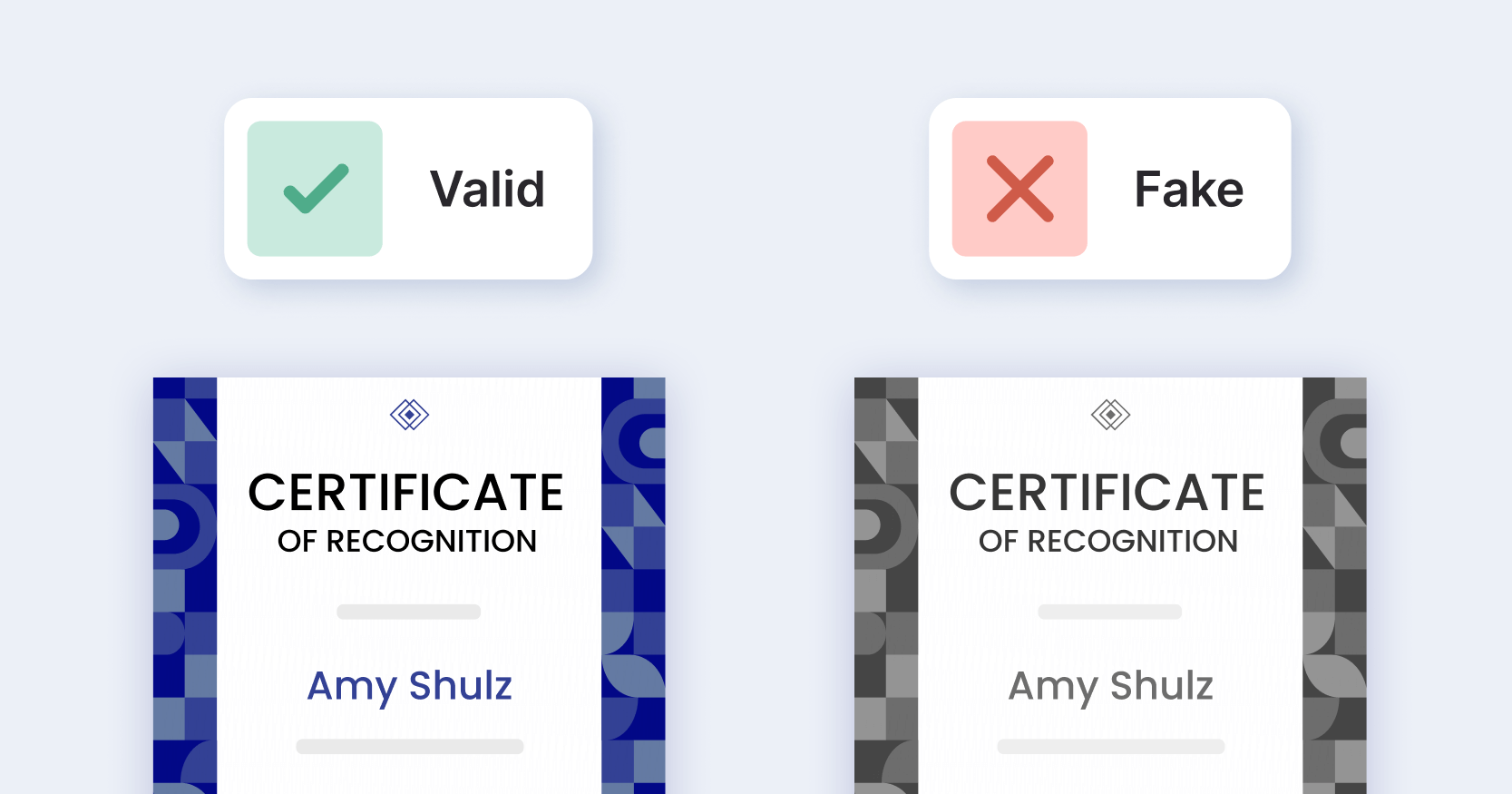Trusted by:
Updated: December 05, 2025
12 min read
How to Spot a Fake Diploma?
Forgeries are becoming more advanced, and knowing how to spot a fake diploma is essential – whether you're an employer, an educator, or a recruiter. Check out our practical steps to help you identify fake diplomas with confidence. Read on!
Schools and universities are more often opting for digital over printed diplomas. It’s a great, and green move.
However, this shift has opened a Pandora's box of sophisticated forgeries, muddying the waters of academic credentials. Knowing how to spot a fake diploma is now more important than ever.
That’s why we’ve created an easy-to-follow guide that demystifies the process with practical steps to help you differentiate between the authentic and the fraudulent.
Ready? Off we go, then.
Decode diploma: Real diploma vs fake diploma
It may happen that, from a distance, a fake diploma looks legit, but then, you wear your glasses, come up closer, and spot some suspicious elements. They might not be visible at first glance and a little less obvious for some people.
A little tip from the beginning: spend some extra time to double-check the aspects below thoroughly.
Paper quality of real diploma vs fake diploma
You might not spot the difference between the paper quality until you hold it in your hands. Authentic diplomas use thick, high-quality paper. If the paper feels flimsy or cheap and doesn’t match the standard of higher education institutions, it’s your sign to double-check the diploma’s credibility.
🔐 Please note that digital diplomas are more secure than printed diplomas. Digital ones include more verifiable features like QR codes and secure unique certificate ID numbers. You can generate them using Certifier.
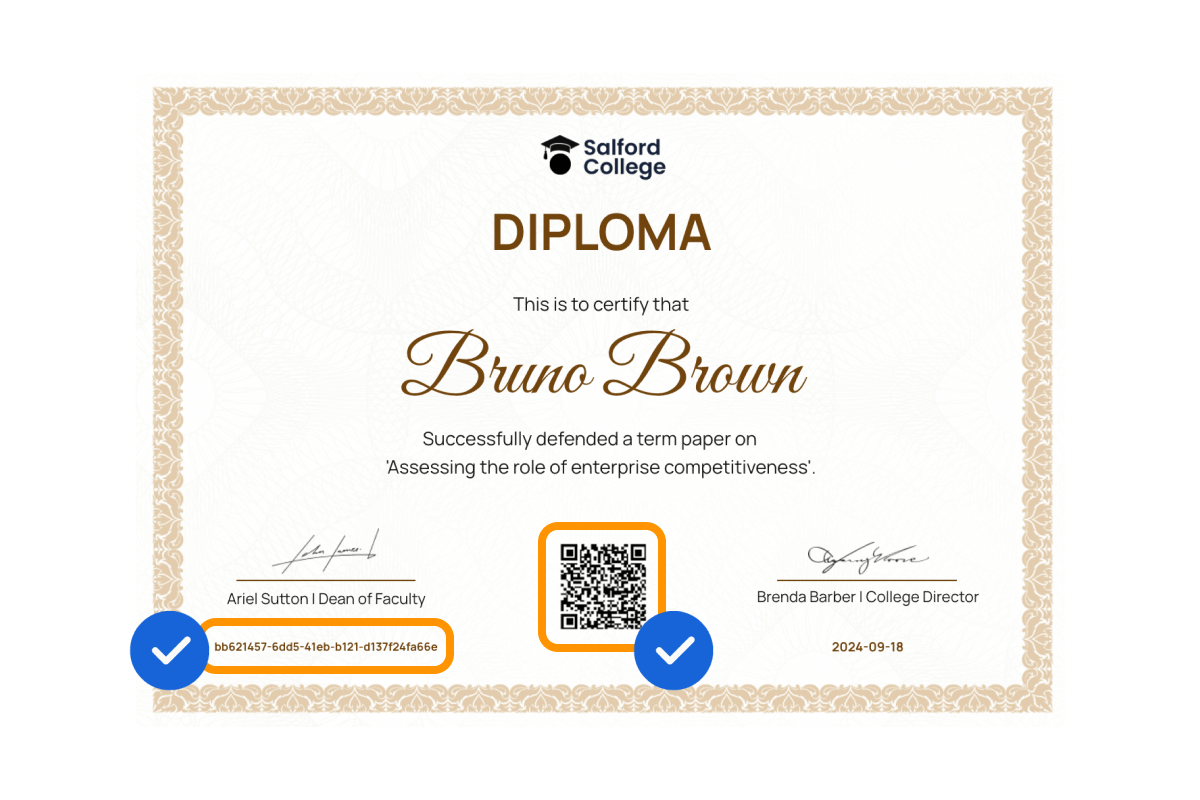
Legitimacy of the issuing institution of fake diploma vs real ones
Numerous sites offer fake degree certificates from unrecognized institutions. Real diplomas, on the other hand, include official badges and seals that are unique to the institution. If your certificate includes copied or poorly replicated seals, lacking the fine detail found in real ones, it’s a big no-no.
Holograms and watermarks are also credibility indicators. They are security features that are difficult to fake. Real diplomas have these embedded for added authenticity. Fake diplomas usually lack these features or present poorly executed counterfeits.
Signatures and grammar in fake diploma vs real documents
Fake diplomas often have generic or missing signatures, which is another warning sign. The real ones have signatures from recognizable figures like the dean.
Please pay attention to correct spelling and terminology specific to the field of study. Very often, fake certificates and fake diplomas have errors or incorrect terminology, which is easy to spot if you know what to look for. Read carefully to spot linguistic mistakes such as punctuation, accurate language, etc.
🧑🎓 How to distinguish real high school diploma vs fake one? A real one is issued by recognized educational institutions and includes official features like authorized signatures, proper alignment, and verifiable certificate IDs or QR codes. It will have no errors in spelling or grammar. A real high school diploma uses consistent, professional language. A fake diploma may lack these details, with unauthorized logos, no certificate ID, and poor-quality printing.
Red flags in fake diplomas
If you want to find out whether your diploma is fake, here’s a list of things you should check. Typically, they’re obvious from the first sign and are nothing more than red flags.
Improper alignment
Low-quality picture and weirdly aligned elements? Maybe the text spacing does not seem right for you? It might sound trivial to others, but it could be the sign of a fraudulent document. Authentic university diplomas and high school diplomas have professionally aligned text and images. If the alignment is off, it signifies a fake diploma.
📃 Looking for guidance on issuing certificates or diplomas? Check out 11 best practices for creating your own diploma.
Unauthorized logos
If the logo doesn’t match the official university branding of legitimate higher education institutions, be careful. Verify the logo by comparing it with the official one on the institution's website or contact the university directly. If there are discrepancies, it’s a strong indicator that the diploma may be fake.
Lack of verifiable details
A real diploma will have verifiable details like a certificate ID, an official postal address, and official website links. Fake diplomas may omit such details, making it harder to verify their authenticity.

Now you know how to spot a fake diploma. What to do next?
How to check if a certificate is original or fake online?
When wondering how to check my certificate online, this is what you do.
Here's a shortcut on how to check certificate original or fake online.
01 Visit the official institution's website and location
02 Scan the QR code
03 Check the certificate ID
04 Use a digital wallet with verified issuer status
05 Compare details with official records
01 Visit the official institution's website and location
Go to the official website of the higher education institution that issued the certificate. Search for the section that allows you to verify such certificates. If you cannot find it, contact the institution directly. Legitimate institutions often provide a way to confirm authenticity certificates. Also, don’t forget to check its location on Google Maps.
02 Scan the QR code
If the certificate has a QR code, use your smartphone to scan it. When using the Certifier certificate builder, the code links directly to the custom URL (for example, an issuer can link to the institution’s website) or a verification page where anyone can verify the diploma’s credibility with a single click. If the scan fails or redirects to an unrelated page, it is a strong indicator of a fake diploma.
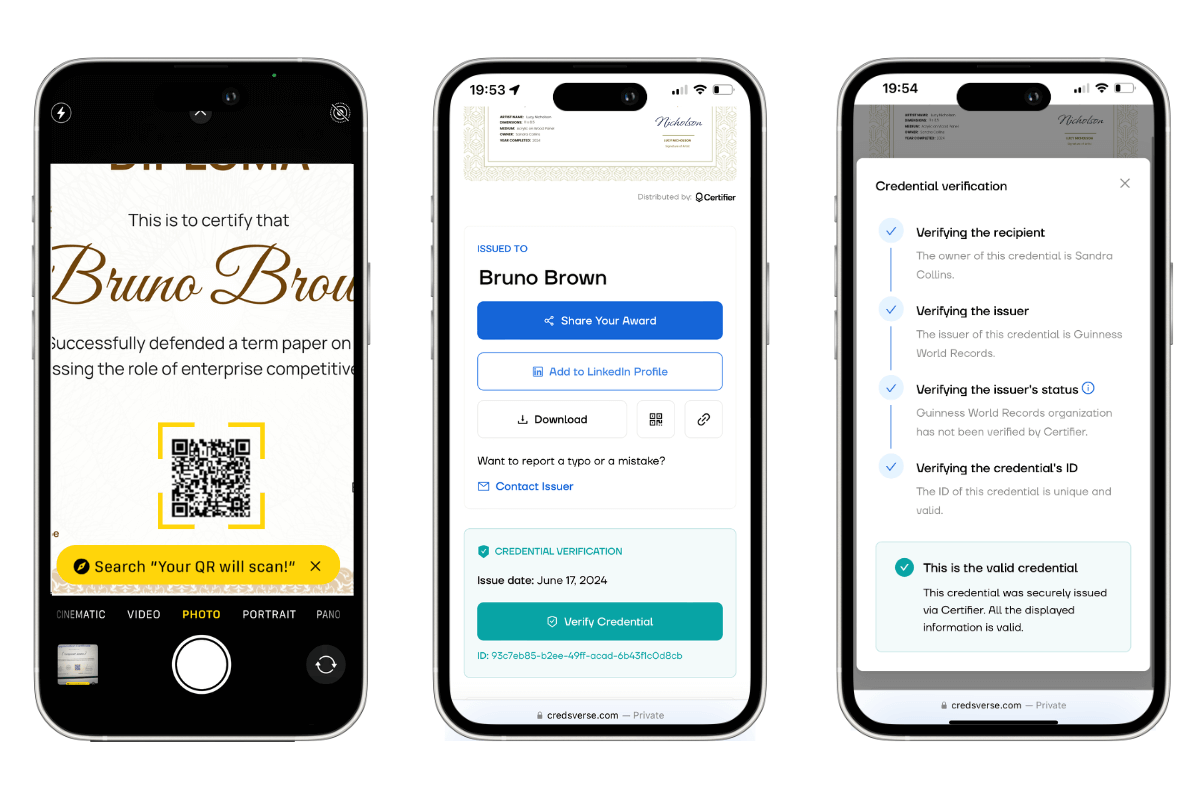
🤳 Did you know that at Certifier, it’s super easy to include a QR code on a diploma certificate? Just drag and drop the code, resize, change the color if necessary, and you’re ready to go!
03 Check the certificate ID
When the ID is invalid or unrecognized, the certificate may be fake. Look for a certificate ID number and enter it on the institution’s verification portal if it has any. Higher education institutions assign unique IDs to each certificate, making it easier to verify online.
04 Use a digital wallet with verified issuer status
Use a digital wallet if there’s such an option. There might be a badge with verified issuer status that confirms the authenticity of the certificate directly with the issuing institution. It's handy for dealing with printed diplomas, where QR codes or certificate IDs might not be available.
👛 This is why a digital wallet is a must: With Certifier digital wallet, a verified issuer status means the issuing institution has undergone a thorough verification process that ensures the institution is legitimate. When you access such certificates in the digital wallet, you’ll see a badge indicating the issuer’s verified status – an instant trust signal.
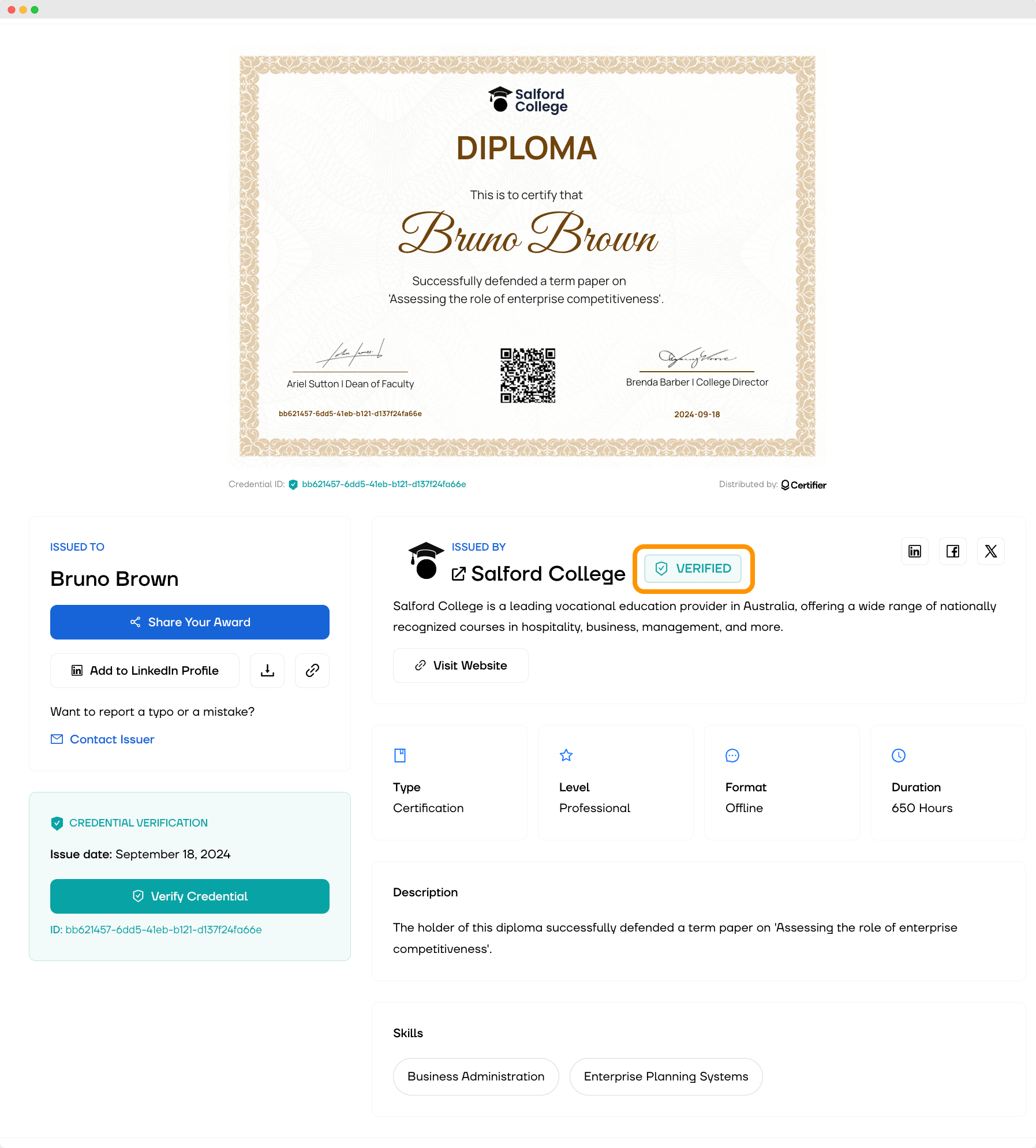
05 Compare details with official records
Cross-check the details on the certificate with the official records from the issuing institution. Look at the names, dates, and other specifics to ensure they match exactly. It is a simple yet effective way how to tell if a diploma is fake.
🤔 Is verifiable degree legit? If they pass the verification processes, then yes. Scan the QR code if there’s any, or give a certificate and a verification check if possible. Remember to verify it thoroughly by examining the aspects we mentioned above.
How can recruiters verify the authenticity of a diploma or degree?
Many recruiters want to know how to spot a fake diploma, but the answer is not always straightforward. So, we would like to show you what to do and how to tell if a diploma is fake.
Look for the QR code on a diploma
If the diploma has a QR code, it’s a good sign. The code should have a proper quality and contrast ratio so it’s visible and scannable. They are typically positioned in the corner or a spot that doesn’t disrupt other design elements.
Scan the QR code using your phone
Once you locate the QR code, use your smartphone to scan it. You will be directed to a digital wallet that houses digital credentials associated with the diploma. In the wallet, you will find the diploma design, the recipient’s data, information about the issuer and course, as well as credential verification details.
Check the info in a digital wallet
Verify critical details such as the recipient's name, degree earned, and the date issued. Certifier offers round-the-clock access to credentials, so recruiters can check credentials anytime they want. Also, even if there were some changes in a diploma, the documents are updated automatically in the digital wallet.
Conduct a one-click certification
In the bottom left corner, there’s a green box that will help you confirm a diploma's authenticity. A single click on the provided button in the digital wallet instantly validates the credentials. It ensures the diploma's legitimacy and guards against fraudulent documents.
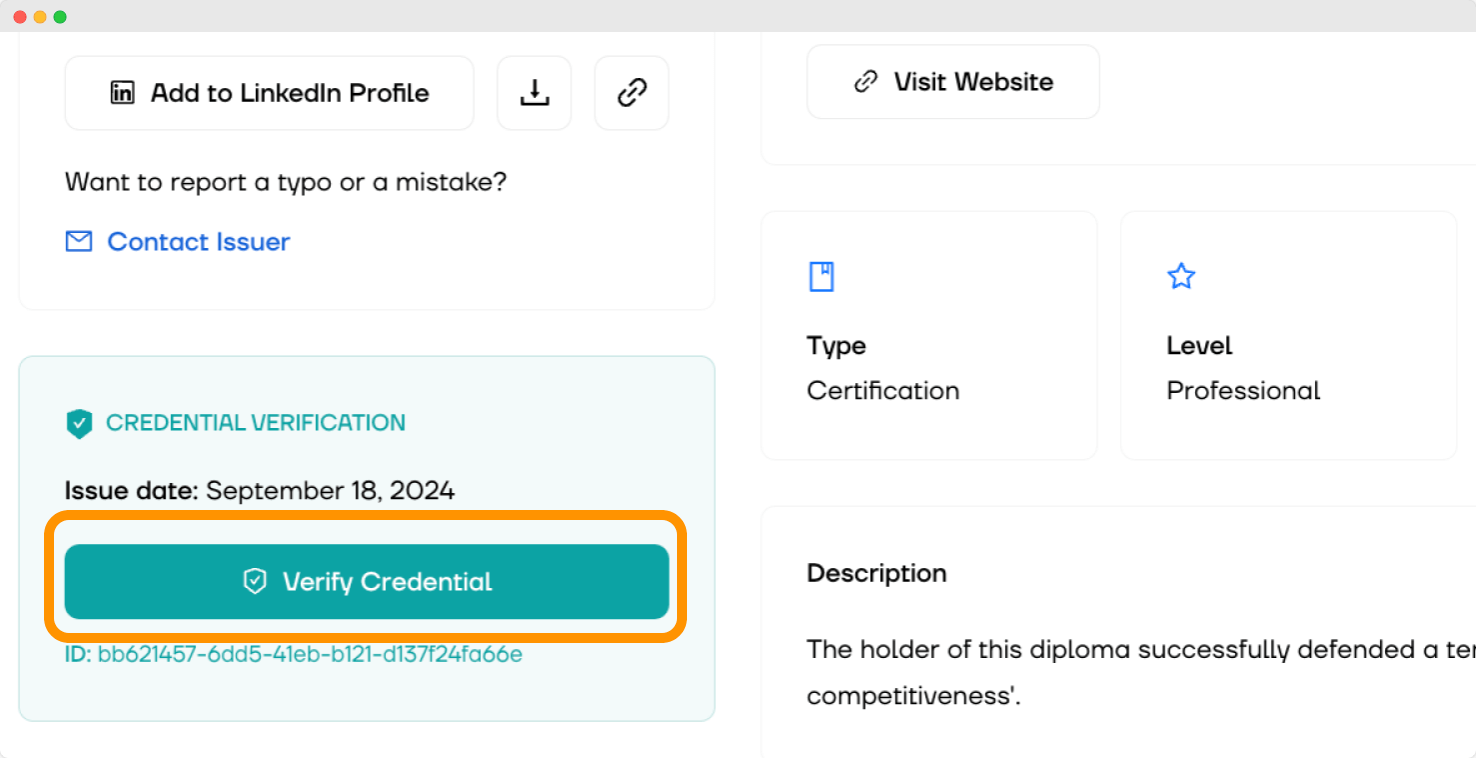
How to identify fake degree diploma?
What do you do when there’s no QR code you can scan? Let us guide you on how to spot a fake diploma step by step.
Check for consistent and accurate information
Review the details on the diploma, such as the institution's name, the degree awarded, and the date of issuance. Any inconsistencies, spelling errors, or awkward phrasing are red flags. Fake degrees often contain mistakes that a legitimate university diploma would never have. Read closely and compare to the official information.
Verify the signatures
A real diploma includes signatures from authorized officials, such as the dean or registrar. Check that these signatures are genuine and not printed or forged. A fake certificate often features poorly replicated or generic signatures.
👋 Would you like to create verifiable diplomas? Check out free diploma templates. All are secured with verification features.
Cross-check the institution’s details
Make sure the issuing institution is real and accredited by visiting its official website or contacting them directly. Pay attention to a verified issuer status, for instance. Fake degrees often come from nonexistent or unaccredited universities, so it’s important to confirm the institution’s legitimacy. Try to call them, go on their website, or contact someone who graduated from this institution to do a fact-check.
Review the font and layout
A legitimate diploma will have a clean, professional layout with consistent font styles and sizes. Any unusual fonts, misalignment, or overcrowded text are indicators of a fake certificate. Fake transcripts or diplomas often fail to replicate the meticulous design standards of real ones, which is a key in how to spot a fake transcript.
Confirm through digital verification
Many universities now offer online verification tools where you can confirm the authenticity of a diploma. If the institution doesn’t have this option or the diploma fails to verify, it’s a strong sign of a fake degree. This method is increasingly common in how to check if a diploma is fake and provides a reliable way to validate a university diploma.
Tips to secure your diploma
Are you an issuer? Check out our tips for securing your credentials.
Leverage API integration for swift certificate checks. It’s a great tip for employers hiring new people or educational institutions. API allows to integrate verification processes into your own systems so that the diplomas can be checked immediately and seamlessly.
Use the Issuer KYC procedure to confirm issuer authenticity. It helps distinguish genuine certificates from fraudulent ones.
Monitor verification analytics to measure how often people verify the certificates you issue. Understanding verification frequencies can offer insights into the recognition and acceptance of your credentials.
Allow to verify credential issuers with one click. Then, anyone can confirm the issuer's status and the certificate's validity directly from the certificate itself.
Keep credential data centralized. Access to consolidated information simplifies management and speeds up the verification process for all stakeholders.
Implement UUID-based verification to prevent fraud. Each certificate's unique identifier protects it against duplication and ensures its authenticity.
Ensure certificates have digital signatures. A digital signature confirms the certificate's credibility and integrity.
Share verification links. Make it easy for others to validate credentials. Place a QR code in the certificate to bring anyone who scans it to the verification page.
Use the best diploma generator like Certifier. For issuers, it’s super quick to generate secure diplomas. For recipients, it’s convenient to verify, share, and print them.
Now you know how to spot a fake diploma
We hope that it’s now easier for you to spot the differences of a real diploma vs fake diploma. Remember to double-check the issuing institution, recipient’s details, and certificate design.
Are you an issuer and want to ensure you have done everything to secure diplomas?
Issue degree certificates with Certifier. Create and send 250 real, verifiable degrees for free. Take advantage of a suite of features beneficial for both degree issuers and receivers. Enjoy management, design, expiration, automation, and a branded delivery experience.
Start using Certifier now and make sure your diplomas are safeguarded.
FAQ about spotting fake diplomas
Any doubts about how to spot a fake transcript on a diploma? Check out the answers.


